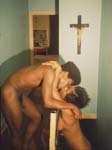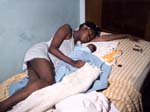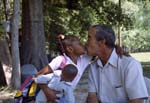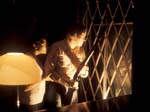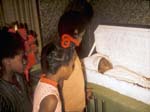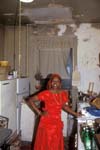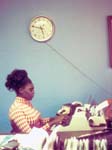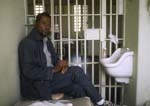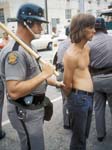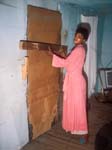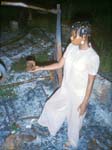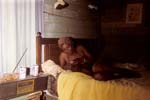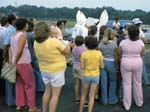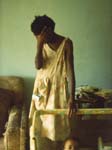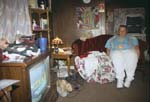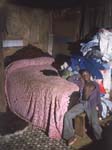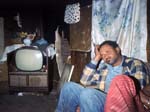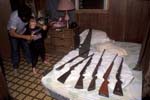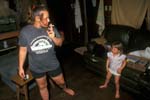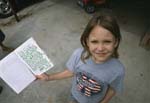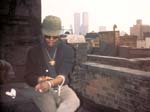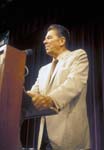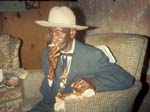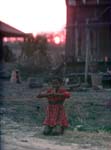|
Picture stories
People often ask me how I
get to take such an intimate picture? Here’s my recipe: ever since
my first year on the road, I had frequently been staying with
Dorothy Y., a big, fat mama in the Philadelphia ghetto. Her
14-year-old daughter Renee was fascinated by my vagabond stories and
always pestering me to take her with me on the road. When she turned
16, I finally gave her permission, if she got her mother’s written
permission. I knew how the police would react to a white hitchhiker
with a black girl, but apart from endless sexual assaults by white
truck drivers the trip went fine. Single, heavily pregnant women often invited me to share their bed and table – perhaps because they were especially vulnerable and needed some protection against aggressive black men, ….or like Eveleen Hall in the picture, in the hope that I could be their redeemer. In 1974, I still hadn’t abandoned my idea of doing a photographic document of black life from birth to death, and when Eveleen kept begging me to move in with her, I saw a chance to finally get a picture of a birth. She was living in the most crime-ridden, poverty-ridden project I had ever seen, and I was so scared to leave the house that I practically behaved like the perfect husband. But the delivery dragged out, and like so many black men in the ghetto, I split when push came to shove. One night, the flames from the race riots out in Newark went up so high that I could see them from our gated windows. All too often, I had hitchhiked thousands of miles to get to a ghetto uprising and arriving too late every time. This was one race riot I did not want to miss. I was really risking my life with bullets flying around me in the flames. But because of a technical mishap not a single photo came out. When I got back to Eveleen, she had just given birth. So in one night, I missed both birth and death. I had a steadfast vagabond principle not to let someone down I had built up a relationship with, for as long as we were living together. Here, I broke one of my strongest principles – and immediately received my devastating punishment. This
picture was taken the next day in the slanting bed I now had to
share with two people. The legs were missing at one end and I was
close to falling out all night long. Shortly after, in fact, I cut
out from this oppressive scene of misery of single welfare mothers.
I was no more of a redeemer than any other jobless young man in the
ghetto.
usa-03878
usa-kkkak02-054
usa-00149 John and his hardworking wife lived in one of those well-kept, expensive brownstone townhouses in Brooklyn that black immigrants favor. On the other hand, almost half of native-born blacks are on welfare, living in projects or in jail, and their neighborhoods are characterized by the trash of despair all over the place. For the same reason, I often heard these "black Jews," as native-born blacks call the immigrants, refer to native-born blacks in the ghetto as "lazy niggers." And I saw how they armed themselves against them out of fear, like John and his wife in this picture. For 30 years in my workshops, I have tried to build up a sense of solidarity between these two groups of blacks, but it’s hard, considering that black immigrants constitute up to 85 percent of all black students in many elite colleges, though they make up just 5 percent of the entire black American population.
In Alabama, this poor 87-year-old woman asked me to drive her to Phoenix, Arizona. She wanted to go there to die. I helped her board up the windows of her tumbledown shack just outside Notasulga – the same town where the government once performed a deadly syphilis experiment on blacks. She knew she would never return, but still she tried to prevent local blacks from moving in. Even as we drove more than 2000 miles in five days, she sat there the whole time with her pistol in her hand – terrified of my long hair and beard. She was so frail that I had to carry her whenever we left the car, and even then she clung to her gun. She reminded me of an old lady I picked up many years later in Atlanta on one of my lecture tours. "Why are you hitchhiking?" I asked her. "Because they shut off the gas to my stove," she said. She had tried to kill herself, but then they shut off her gas. Now she was hitchhiking 400 miles to Greensboro, where she knew her sister had a working gas stove. I always help my hitchhikers out, and so I chose to drive this almost 80-year-old woman straight to the oven.
usa-05057
I was staying with Maryann W. in New Orleans and we went out one night – it was Sunday, December 9, 1973 – to play pool at the Seven Seas. I played a game with a black friend of mine, Butch, and when it was my turn he stepped outside for a minute. When he didn’t come back, I went outside to look for him and found this man dead. Butch had just murdered him while we were playing pool. My friend Maryann recently wrote about it on Facebook: "If I hadn't stepped in at the right moment you would have been arrested for taking the photos. I can still see Butch's face in the back of the patrol car. I had talked to him a lot in the bar, he never gave me any trouble, and I remember his stating that he had never been out of jail at Christmas since he was about 10 years old. As your records will show, he lived up to this by attacking the man on the street. I remember when I looked at him sitting in the back of that patrol car he shrugged as if to say, "I told you so." Very sad. If I had been a psychologist at that time I would have taken him on as a client." Later, Maryann worked with poor migrant workers, but that night we went home and made love. Sex and violence are closely interlinked.
Raine, in the picture, was my first inside source about everything in the Ku Klux Klan. She was the mastermind behind Klan leader Virgil G., who killed the former girlfriend of my best black associate, Tony, in the 1979 Greensboro massacre. I tell more about her in the film playing in the Louisiana Cinema – how, at 17, she had already committed two murders and was then sent out to do missionary work in Africa by good Christian Klan people. It was there that she decided to help black people back in America, and she later got a degree in social work and worked with black gang members in prison. One day, two Klansmen, David and Scot, whom I’d met and photographed, broke into her house and raped her, after which they tried to murder her with multiple shots. It took several blood transfusions before doctors were able to save her life. In the trial, it came out that she was an active member of the Klan and she was therefore fired from her job at the prison because the state is not allowed to employ KKK people. But then all the black prisoners protested. They didn’t want to lose their favorite social worker. "But, didn’t they realize that Raine was a Klan member?" Sure, they all knew from the prison’s gang awareness training, a program to help ex-cons stay out of gangs. For in a prison context, the Ku Klux Kan is considered to be just a poor white gang, and the inmates had recognized Raine in a slideshow about the local white gang. And that made her even more popular among the black inmates – that she was a gang member like themselves. So the prison had to hire her back.The last time I visited her, Raine had amassed this stockpile of guns because she was afraid of further attacks by violent members of her gang. She is one of the many examples I have seen in the Ku Klux Klan of "love disguised as hate."
usa-01554 After church services in Harlem recently, I decided to look up old friends in the neighborhood. Harlem has received a huge economic boost and several of my poor friends have been forced out because of rent hikes. A couple of me friends in the same building had moved out, so I was anxious when I knocked on Martha’s door and relieved to hear her scream of delight from inside the apartment, "Jaaaacoooob!" I last stayed with her during my college tours in the 1980s when she was still hot as a hooker and I took this picture of her in the red dress in her kitchen.
So it was a bit depressing to see her now, toothless and barely able to walk. Here she is in what’s supposed to be the living room, where I used to sleep when I went to weddings and parties in Harlem. Although she had got in late the night before, she now insisted on dressing up in her usual party gowns with gold chains around her neck, the way I knew her back in the day.
It was oppressively hot, so I asked her out for a walk in the park. That’s how I realized that this old hooker could only get around now with the help of a walker. Even so, she said what she always used to say, "It’s a bad neighborhood, but I’ll protect you!" I thought that was funny, being "protected" in Harlem by an old lady with a walker, but the local gang members had deep respect for her. She would stop and chat with everybody, and I was amazed at all the new friends I made in no time.
We bought some beer in her local grocery, which like so many other stores in Harlem today are owned by Arabs. They have taken over the old Jewish stores I remember from my youth. The beer helped loosen up her first customer later in the day – Ron, an old regular who is a semi-boyfriend. My small photo story ends with them in bed together in the messiest bedroom I have seen in years – so cluttered that only half the bed can be used for business as usual. The other half is taken up, among many other things, by her cell phones, her lifeline to the outside world, and she spends most of her time in bed trying to find them when they ring, which happens less and less frequently. It’s wonderful to see old friends, but not always so uplifting.
I was hitchhiking to Greensboro, North Carolina, when I ended up staying with Mack, a black social worker. He asked me to give a talk to the black inmates who were bussed in for therapy at the Drug Action Council every day. I talked to them for two days, and after asking me a lot of questions the first day in the end they became totally silent out of embarrassment. This was in those days when blacks hated whites, and they had never met a white person whom they felt knew more about their situation than they did. As one of the assistants told Mack, "It was as if Jesus walked through my house and told me everything about what was wrong with it." That made Mack burst out in laughter, because just the night before I had told him about the white Jesus image many Southern blacks had and frequently projected onto me.
Gee, in the picture, was so impressed, too, that in everyone’s
presence she asked me to come and stay with her, which was unusual
for a black woman at the time, when such behavior was considered
betraying your race. But Gee, a former prostitute-addict in
the North, was used to white men, even if she had only known them as
business – a penniless vagabond was a new experience for her. Every
day I’d go with her to work at the clinic. After serving a prison
term, she had got an office job there as part of her rehabilitation.
The last time I visited her two years ago, she was working in a
hospital. In Georgia, I stayed with the Barnett family in one of the old Gone with the Wind plantation homes. There, I learned about a different form of racism, one not based on hate but on a historically determined paternal love of black people. Mrs. Barnett spent days taking me around to visit families whom her family had once owned – in her mind set apparently few years ago and, as I later found out, the same held true for in black consciousness. Just as in the plantation homes of Mississippi, I enjoyed being served from morning to night by black servants, some of whom are still my friends today, - now when Mrs. Barnett and her era are dead.
4-5004
The story about the prison leader
Popeye Jackson was told in American Pictures, but let me here tell
you the story of how I got into prison and took these photographs
just a few days before my friend Popeye, in the picture, was
assassinated. I had been active in the same city, San Francisco,
four years before in the world’s first successful gay-rights
movement – the same movement that brought Harvey Milk to power seven
years later. As a gay activist, I became good friends with the
sheriff of San Francisco, Hongisto, who as a gay was still not out
of the closet. I could therefore talk him into jailing me illegally
so I could photograph our mutual friends – all the transvestites
whom I lived with at the time and who frequently ended up in jail.
Funny also that Hongisto himself was later locked up in that same
prison when he refused to allow police to evict gays from their
apartments, as the law said they should be if they were guilty of "sodomy,"
as it was still called. When a friend of Popeye’s and mine, Sara Jane Moore, tried to kill our president at the time, President Ford, to avenge the FBI murder of Popeye, it was actually one of my neighbors, Billy – a gay man who was the boyfriend of Harvey Milk’s lover Joe – who knocked the pistol out of Sara’s hand and saved the president’s life. As an instant hero, Billy was invited to the White House, but when Milk convinced him to announce that he was gay, to help strengthen the gay rights movement, the president suddenly refused to meet his own savior.
This year, when I was taking pictures
under these highway overpasses in the world’s biggest village, Baton
Rouge, I discovered that many of the same people that I’d
photographed in their shacks 35 years earlier were still living
there. But now they didn’t want to be photographed as victims. "We
live here of our own free will."
usa-03604
In 1972, I was hitchhiking around
Guatemala with a vague idea of joining the guerillas, since Nixon
had bloodily overthrown the first democratically elected government
in Guatemala’s history. It was those years when the U.S. was still
acting as a terrorist.
Mary 1: I have always been against intimate relationships with our outcasts in the underclass – it will always be a kind of exploitation. Thus I have consistently refrained from having relationships with poor women in the Third World. But Mary was an exception. I came to her shack, which had no indoor plumbing, to get a glass of water in the sweltering heat of summer and we ended up – in more than one sense – sharing water at the well of the Samarian woman. Mary and I romanticized our forbidden relationship there in those tough surroundings, but she didn’t trust people like I did: she kept three pistols and a shotgun under her bed. Those were some of the happiest days of my life and we have maintained our close relationship throughout our lives despite our differences of class and culture. Once, when I was going away to a Ku Klux Klan rally in Kentucky, Mary gave me a silver cross to protect me on the trip. The same day I took this picture of her barring the door – as if she knew what was going to happen.
Mary 2: Those who seek to preserve a caste system will always condemn such relationships. Americans – out of pure and simple guilt about the tacit apartheid in their own hearts – tend to blame Mary’s misfortune and our Shakespearean tragedy on me. Likewise, we Europeans are always blaming Americans for their primitive resistance to intimate bonds between blacks and whites, while we forget our own disassociation from intimate interrelationships with the Muslims. All over the world, the minds of both oppressor and the oppressed are full of blocks against mixed marriages and intimate relationships.
usa-01940
Mary 4:
Mary 5: On my first lecture tour in 1978, I picked up a lost hitchhiker who seemed completely withdrawn, and something about his voice made me suspect incest. For a long time, I very lovingly kept asking him about his childhood. And sure enough, from the depths of his soul slowly emerged a horrendous story of a stepfather raping him, which he had effectively kept a lid over. I was as surprised about the memories that emerged as I was that he would now share them with anyone. In a short time, this tangled-up knot of a young man was transformed into a big bundle of gratitude and would do anything for me. When I showed him a copy of my book (about the black underclass), he suddenly asked me if I would like to go with him to the Ku Klux Klan rally he was going to. I had never in all my years as a vagabond been able to get in touch with the Klan. Now, one of its members was suddenly opening up to me and offering to help me take candid pictures of the secret cross burning, essentially betraying his friends. I knew that I would be able to trust him from now on, because I have always met deep gratitude from such victims of abuse after helping them. He was the first Klansman who opened up to me about the sad cause and effect behind the scary facade of the Klan. Years later, when I started seriously working with the Klan’s racism, that pattern was confirmed – just as it can be discerned in almost every one of these poor Klan sympathizers.
usa-00567
In
2002, when the leader of the biggest and most dangerous chapter of
the Klan in America went to prison, I moved in with his wife, Pam,
who was now the acting Klan leader. She and the other Klanspeople
grew so fond of me that she invited some of the so-called Grand
Dragons from other states to Sunday dinners to meet me. Here,
following the initial saying of grace, I’m having dinner with the
Grand Dragon of Illinois and her personal bodyguard, who also
happens to be her husband. So, in this image I wanted only to exhibit our own hate.
usa-03764 How do I know? Although I saw her heil all her childhood amid all the ordinary storybooks and Lego toys I got her for her birthday, she is a normal loving person today. So are her parents, after they got some help to get out of the Ku Klux Klan and the Nazi Party.
Still, most of us try to keep them fixed in such hate groups by
cultivating them as evil and directly teaching our own children hate
– rather than understand – for example, when they have to write
papers about the KKK in school.
usa-kkkak05-036 There, she flopped her saggy breasts out of her blouse and pulled down her paints to show me her tattoos, including some on the most intimate parts of her body. Her entire life, her husband had been against her getting tattooed, because he was beaten as a child by a drunken stepfather with tattoos. But what is a Klan woman without tattoos? In their constant struggle to try get our love, these children of pain get it in inverse form instead, in the form of our negative attention or outright hate and condemnation – first in their youth as tattooed bikers, later much more effectively by putting on these clown suits. Jean’s three kids all disassociate themselves from their mother’s pathetic Klan activities, but she can’t disassociate herself from them. They are all in prison for dealing drugs and she is committed to raising her grandchildren. But mentally she now feels like a free woman.
I came to live with Nell Hall in Jersey City in 1974, when I moved in with her pregnant daughter, Eveleen. As a poster this picture became extremely popular among American feminists as the symbol of the worn-out welfare mother. I don’t remember if the baby was actually Eveleen’s. Nor did it matter in the bleak setting of poverty ridden projects, where the only pastime – apart from crime – is round-the-clock TV. It was really hard for me to pass the time there, so I had plenty left over to wait for the right facial expression which conveyed the hopelessness - before the heartening entrance of the stranger in their lives.
Nell Hall was soon evicted because she
couldn’t pay her rent of 59 dollars a month. They became homeless
and I lost touch with them. But I think about her and her daughter
all the time when I drive past these now-condemned poorhouses on
Highway 9, where kids from our slum apartments used to unload the
backs of trucks with lightning speed when traffic backed up during
rush hour. For the place is right next to where I warehouse my
equipment and the posters with Nell. In the room next to mine the
Arab terrorists made the bomb which blew up the WTC the first
time……and according to the FBI they were close to also blow up all
Nell Halls left over papers.
Driving Robert Moore, the Grand Dragon of North Carolina, home from the Ku Klux Klan headquarters in Indiana, I met Nancy, the first of his four ex-wives. He’s back living with her again now – or rather, he sleeps on this couch. "While your wife is fucking a Mexican in the next room," I tease him, when he starts spouting his Klan catchphrases such as "I stand up for my race!" and so on. Today’s Klanspeople are more upset about Mexican immigrants than blacks. "Yeah, but that wetback was a good stepfather to my son all the years I was off with the Klan," he shoots back, grinning. Robert met Nancy when he got out of jail at age 19. He couldn’t move back home, since he had spent five years in prison for trying to kill his abusive stepfather with a razor blade after a lifetime of beatings. On another occasion, his sister tried to cut their stepfather’s throat with a kitchen knife. His brother has been in and out of jail his whole life for arson. That’s just another way of burning your crosses – the same psychological pattern which characterizes every Klan member after an abusive childhood. When
he got out of prison, Nancy and Robert only had black friends, she
says about their drug-marriage. But then he straightened himself out
by joining the Ku Klux Klan and suddenly he only wanted white
friends. And because of all that nonsense we went our separate ways,
Nancy says. Every single boyfriend she has had since then has been
black or Mexican. Now, after his heart surgery, Robert can’t work
anymore and, poor as dirt, he’s back living with Nancy, who’s proud
of having slimmed down from the 400 pounds she used to weigh back
when she couldn’t even sit in the red couch. Their son Jason is just
out of prison and runs around bragging about how he wants to be a
great Klan leader like his now-returned dad. So now he’s losing all
his friends since he’s the only white kid in an all-black school.
Yes, sometimes it’s to find out which side you belong to. When I was doing my lecture tours in the 1990s, I would often share this bed with Wilma in her one-room shack without light or water. Teaching at elite colleges for privileged kids you easily forget what it was that made the lectures so successful in the first place – the roots you continually need to be nurtured from to keep up your inspiration and indignation. And no one has been better to return to than the intellectual Wilma, who always would challenge my thinking on racism every night by the fire. At Wilma’s, same as when I’m staying in shantytowns in Africa and Haiti, I get to reexperience the particular feeling of lying packed together on damp sheets between black, greasy bodies reeking of smoke that I remember from the shacks of my vagabond years. Back then I thought that was a special smell blacks had. Later, when many of them got indoor plumbing, air-conditioning and heating, I realized that the smell was environmentally defined, and that it was really the odors of oppression I had been breathing in. So how would I be able to give lectures on oppression without still smelling its odors? After I married my first wife, Annie Rush, I hitchhiked from San Francisco to meet my parents-in-law in Philadelphia, Mississippi. Annie was afraid to return, because people there still remembered her as the first black person to use the former all-white library. Living with Reverend Rush, I made friends with everyone on his street – that is, the dirt road here on "the wrong side of the tracks," as the ghetto is called in America, with its long row of shotgun shacks. In one of them lived Carl O., seen here, with his brother Benny and their father, who was in a wheelchair. Benny has ever since he grew up been in prison, but Carl has done okay, although every time I returned over the years I immediately recognized him his new shacks, because he was always sitting in the same defeatist position. Perhaps he was ruminating on the painful life all around him. In 2007, when I asked him if he wouldn’t like to go with me to my now deceased father-in-law’s old church, he said, "No way, now I have my own church." And so, assuming a similar dangling position, I had to sit through a three-hour sermon he gave, dragging me through fire and brimstone like the best of the black preachers. Who would have thought that eight-year-old child had such power in him? I made friends with Lep, a gangster, who in 1973, having served jail time in New York, asked me home to visit his parents in the woods of North Carolina. We became life-long friends. Yet, it wasn’t until 30 years later that I find out the truth about Lep’s dad, Lefus W. When I was there, he was always sitting or lying around, drunk and beat, like in this picture. So I used to photograph him like this to illustrate the deeper apathy I saw in many poor blacks. This truth about the underclass may have been close to the truth, but Lefus is also a good example of how pictures can lie, even to the photographer. Contrary to the image of the "lazy drunk nigger" with his family in disarray, which is what most American read from this picture, everyone without exception made it clear to me that Lefus had never missed a day of work in his life. As a tenant farmer, he first started drinking on weekends, but he lost his land when white farmers pushed out the black farmers. He then became a construction worker, and his crew picked him up every morning at five and took him to Raleigh where he worked on every skyscraper seen in the state capital today. He only began drinking after work – that is, when I visited in the evening. My superficiality came from never having lived with the family. Every time I visited them since, they were living in a new tumbledown shack, but they were always the tightest of families and still get together every Sunday. Undeniably, Lefus built America. I see that now. So how could I lie to myself and everyone else for 30 years with this picture?
usa-03123
usa-03626
usa-03610
John 4: John 5: John 6: So the circle of oppression keeps turning for this deeply traumatized family that I have now been following through four generations and will likely follow for the rest of my life – like I do with all my other exciting American friends.
usa-00048 That same day, the police suddenly arrested me in the middle of the interview, charging me with being a "communist infiltrator," who was stirring up the blacks. What I didn’t know was that the poor blacks were in the middle of a battle to save this natural area and their houses against speculators who wanted to flatten it all and build shopping malls. The speculators won, and where these shacks once stood the vast College Park mall now lies. Every year, the U.S. in similar ways clears a natural area equal to the state of Connecticut for suburban sprawl.
These hands clasped in prayer are the hands of an executioner. They belong to my father-in-law, the Reverend Jake Rush. Now, after the death of my ex-wife, these hands have acquired a special meaning for me. I really hope the good preacher was praying for forgiveness for the way he abused my ex-wife, Annie. I personally got along fine with him when I was staying with him to investigate the truth about the nightmare of a childhood he gave Annie. Our marriage couldn’t survive the traumas it all gave her later in life. Annie’s mother, reverend Rush’s daughter, became pregnant by a college professor when she was 16. This was such a grave sin in this Baptist minister’s family that she and Annie’s twin sister were sent into exile up north, while Annie was raised by her grandparents in the strictest piety. In tears, Annie told me about the woodshed behind the house where she was constantly being tied up by these pious hands and lashed until she bled. Night after night, during our marriage, Annie would cry out the pain of her childhood, but it was only when her childhood friends described all the details and showed me the shed that I truly realized the evil he had done. Such a pattern of oppression easily becomes a cycle. Thus I had met Annie because her own mother was shot to death in Chicago only half a year after her stepfather was murdered.
usa-03212
The picture shows Jean Ellison
teaching her grandchild with one eye on the TV blaring by another
bed holding just as many sleeping kids as the one we see here. With
piles of clothes everywhere between the cardboard-papered walls, it
was almost impossible to photograph in there. It has always been a
mystery to me how Christians who live piled one on top of the other
like this still manage to put on their Sunday best for church. When
I came back the next year in 1990 the easily combustible shack,
which stood in water outside, had burned to the ground in one of the
stove fires that are so common. This picture was taken on the trip
where Pia and I had to flee north with Hurricane Hugo in hot pursuit
– the same year that the wall fell in Europe.
This picture of Diane injecting Aline with heroin was taken the night after Aline killed a taxi driver. The night before I had come hitchhiking into Jacksonville, Florida, where I met Diane, a black girl, who promised to find a place for me to stay. She and her friend Aline had me wait in a nightclub, while they looked into the options. A while later, they came back wildly agitated and said we were going to a motel. We were all sharing a bed and I watched as they were praying all night, in between their attempts to shoot up heroin, "Oh, please, God, don’t let him die." To get money for a motel room they had made a blown job on a white taxi driver in a dark alley, but then – it gradually dawned on me – they hit him over the head with a paving stone in order to get enough money for a shot of heroin, too. The next morning they overslept and were mainly sorry for being late for church where they sang in the choir. The
following night, they again went looking for a place for me to sleep,
and after a long walk we ended up with their drug friend Don.
Shortly after I took this picture, we all lay down to sleep on his
mattress, and in the dark I listened to them having wild sex.
usa-00379
I took this picture of Reagan eight years before he became president, back when everyone was laughing off this B-movie actor’s presidential aspirations. I fooled him and the Secret Service by sneaking into the Republican headquarters wearing a shorthair wig and a pinstriped Republican getup. I still remember his demagogic speech and how he lied, claiming that the U.S. had the world’s best healthcare system. Because I had already seen so much disease and infant mortality in America, I had made a thorough study of U.N. health statistics. Not surprising that he as president brought the US into the biggest foreign debt ever with his demagogic tax releases while rolling back many of the big gains made for blacks during the civil rights years.
On April 10, 1974, I got one of my most important rides as a vagabond. A black social worker, who picked me up and saw my pictures, asked me if I would like to meet America’s last surviving slave and took me to 134-year-old Charles Smith, seen here. His moving story, which I caught on tape just before his death, goes back to how he was caught in Africa, lured onto a slave ship and sold at auction in New Orleans to a white farmer.
I call this picture "The Beauty and the Beast." During the Watergate hearings in 1974, we all felt that we were finally getting to stick it to President Nixon, the great hate object of young people and blacks in those years. This picture was taken the night of a speech Nixon gave shortly before resigning, when I was living with my girlfriend Baggie in Greensboro. I loved Baggie’s big afro and the whole "Black is Beautiful" movement the afros came to symbolize that was a showdown with centuries of black self-hate. Today, it’s harder for me to tell who the real beast is. Just one month later, Baggie was arrested for bank robbery and sentenced to 25 years in prison.
When
I was hitchhiking back to visit Mary once, I didn’t make it to her
shack in the woods outside town before dark. I had to find a place
to spend the night in Union Springs and somehow I became Nina’s
boyfriend, too. It was a bit embarrassing in those narrow-minded
towns – especially when the mayor once recognized them both in my
book.
My story here is about little Linda in the red dress which moved Americans in American Pictures. Her family was so poor that they had never even had any light in their shack before I bought a little kerosene for their old lamp – so nine-year-old Linda no longer had to do her homework by moonlight. Linda’s life later on was no bed of roses either. Shortly after I took these pictures in 1974, her family broke up and when I returned in 1978, she was being raised by a strict foster mother. Every time I returned, she was completely wasted on drugs and more and more often in jail. The last time I spent time with her, in 2003, she was finally out of prison, but police were constantly cruising around the house in Tampa where she was staying with her two sons, both drug dealers. Shortly after I went back to Denmark, I got a letter from her asking me to send money for lawyers. She was back in jail – and this time so were both her sons. Well, if anyone thinks I got rich off my American pictures, they have no idea what it costs to have so many friends in prison!
Copyright © 2009 AMERICAN PICTURES |
|
